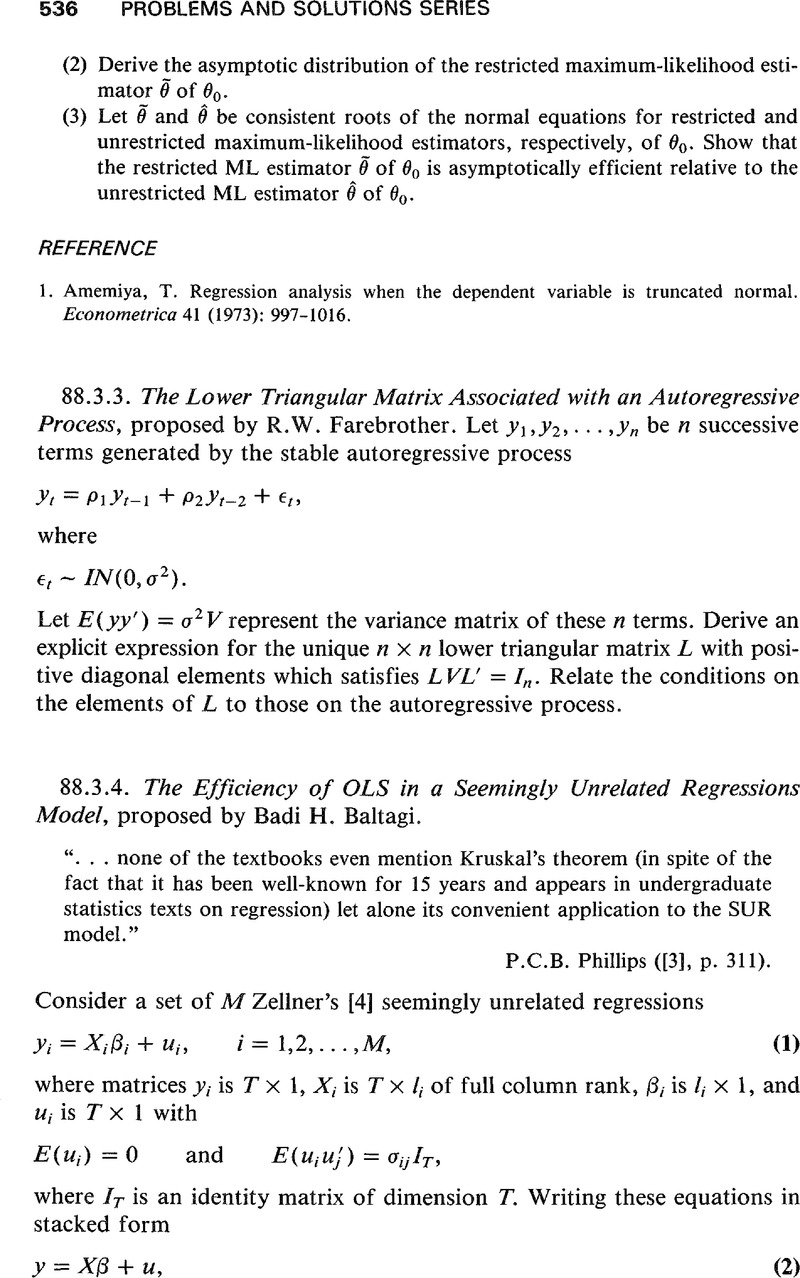Crossref Citations
This article has been cited by the following publications. This list is generated based on data provided by Crossref.
Baksalary, Jerzy K.
and
Trenkler, Götz
1989.
The Efficiency of OLS in a Seemingly Unrelated Regressions Model.
Econometric Theory,
Vol. 5,
Issue. 3,
p.
463.
Baltagi, Badi H.
1989.
Applications of a necessary and sufficient condition for OLS to be BLUE.
Statistics & Probability Letters,
Vol. 8,
Issue. 5,
p.
457.
Bartels, Robert
and
Fiebig, Denzil G.
1991.
A Simple Characterization of Seemingly Unrelated Regressions Models in which OLS is Blue.
The American Statistician,
Vol. 45,
Issue. 2,
p.
137.
McALEER, MICHAEL
1992.
Efficient Estimation: The Rao‐Zyskind Condition, Kruskal's Theorem and Ordinary Least Squares*.
Economic Record,
Vol. 68,
Issue. 1,
p.
65.
Baltagi, Badi H.
1999.
Econometrics.
p.
252.
Baltagi, Badi H.
2002.
Econometrics.
p.
253.
Shin, Dong Wan
Joon Kim, Han
and
Jhee, Won-Chul
2007.
Asymptotic efficiency of the ordinary least-squares estimator for sur models with integrated regressors.
Statistics & Probability Letters,
Vol. 77,
Issue. 1,
p.
75.
2008.
Econometrics.
p.
237.
Firinguetti, Luis
and
Rubio, Hernán
2008.
Some Asymptotic Properties of Ridge Regression in a System of Seemingly Unrelated Regression Equations.
Communications in Statistics - Theory and Methods,
Vol. 37,
Issue. 15,
p.
2433.
Baltagi, Badi H.
2011.
Econometrics.
p.
241.
Pastpipatkul, Pathairat
Maneejuk, Paravee
Wiboonpongse, Aree
and
Sriboonchitta, Songsak
2016.
Causal Inference in Econometrics.
Vol. 622,
Issue. ,
p.
437.
Gong, Li
2019.
Establishing Equalities of OLSEs and BLUEs Under Seemingly Unrelated Regression Models.
Journal of Statistical Theory and Practice,
Vol. 13,
Issue. 1,
Baltagi, Badi H.
2021.
Econometrics.
p.
279.
Güler, Nesrin
Büyükkaya, Melek Eriş
and
Yiğit, Melike
2022.
Comparison of Covariance Matrices of Predictors in Seemingly Unrelated Regression Models.
Indian Journal of Pure and Applied Mathematics,
Vol. 53,
Issue. 3,
p.
801.
Zhu, Kongliang
Zhang, Xuefeng
and
Jaroenwanit, Pensri
2023.
Integrated Uncertainty in Knowledge Modelling and Decision Making.
Vol. 14375,
Issue. ,
p.
236.
Amavilah, Voxi Heinrich
and
Rodríguez Andrés, Antonio
2024.
Knowledge Economy and the Economic Performance of African Countries: A Seemingly Unrelated and Recursive Approach.
Journal of the Knowledge Economy,
Vol. 15,
Issue. 1,
p.
110.
Ilboudo, Abdoul Kader
Dione, Michel
Nijhof, Ard M.
Groschup, Martin H.
Traoré, Ousmane
Ilboudo, Guy S.
Tarnagda, Zekiba
Savadogo, Madi
and
Bett, Bernard
2025.
Factors associated with knowledge, attitudes, and practices of mixed crop-livestock farmers on Crimean-Congo hemorrhagic fever (CCHF) and other zoonoses in Burkina Faso.
One Health,
Vol. 20,
Issue. ,
p.
101066.
Tian, Yongge
and
Jiang, Bo
2025.
A study of BLUPs under a family of seemingly unrelated linear mixed models.
Communications in Statistics - Theory and Methods,
p.
1.


